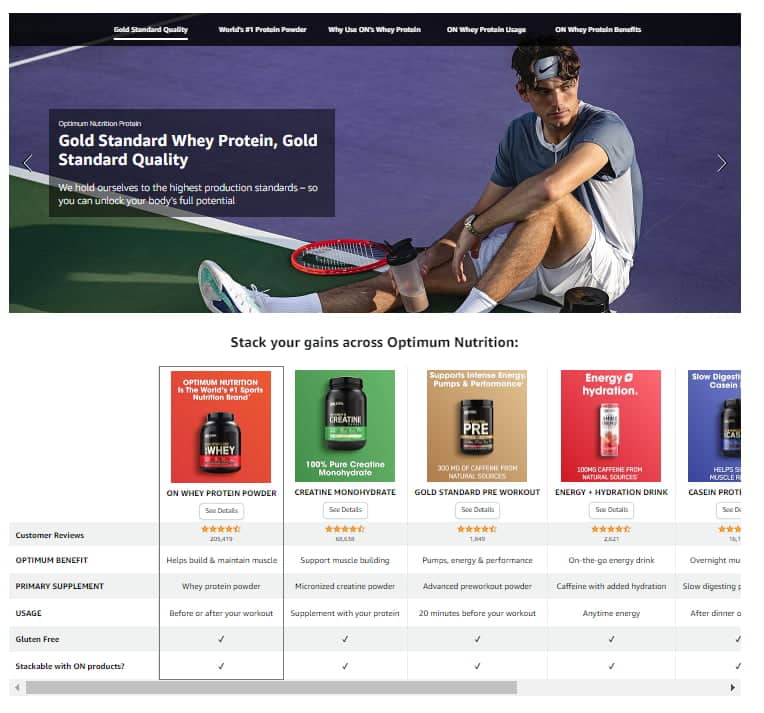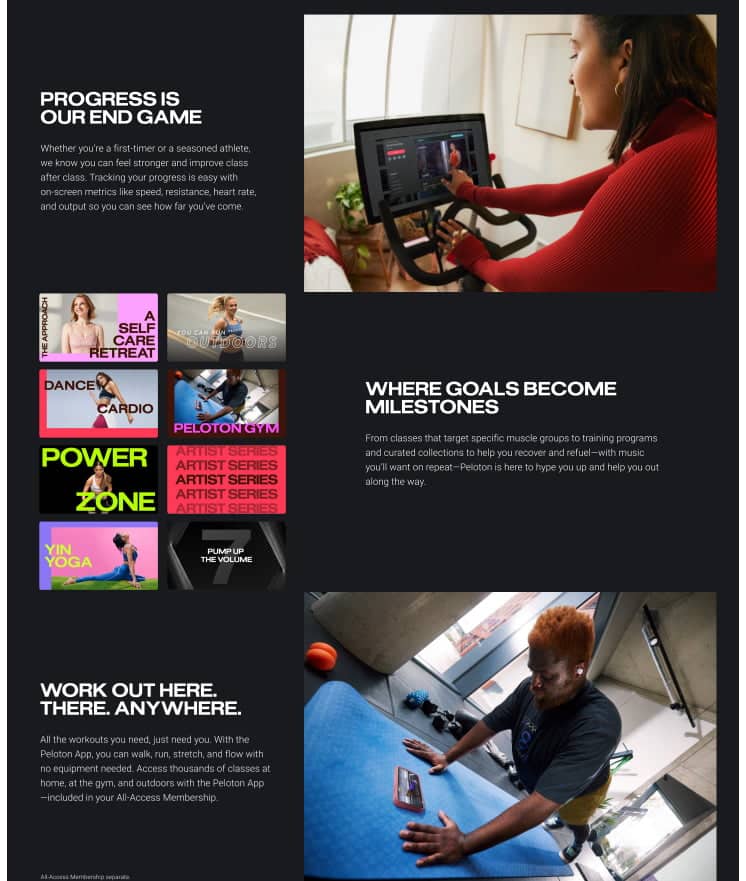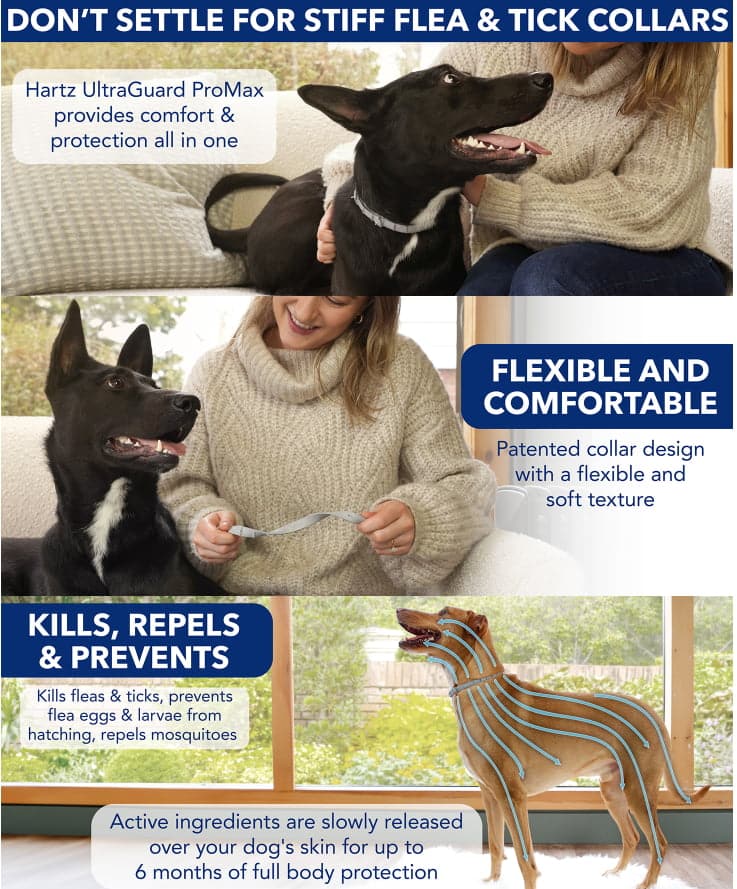On the surface, A+ Content sounds like a colloquial term referring to content that resonates with customers and drives sales performance. However, on Amazon, A+ Content is a unique tool within the seller interface that can allow businesses and brands to create a more dynamic and compelling way to tell a product’s story. If you’re interested in creating competitive, compelling messaging about both your products and your Amazon brand story, this is everything you need to know about Amazon A+ Content, including what it is, how it works, and how to best leverage it to see success.
Key Takeaways
- For brands looking for an elevated presence on Amazon, A+ Content can be a good way to stretch beyond the limitations of a basic product detail page.
- Amazon A+ Content allows eligible brands and vendors to add videos, pictures, and charts to product listings; Premium A+ Content, while not free, can provide even more expansive options.
- A+ Content comes in two overarching categories: Enhanced Product Descriptions and Brand Stories.
What is Amazon A+ Content?
Amazon A+ Content is a unique way for sellers to present product information that goes above and beyond the basics. Rather than sticking to just 2,000 characters of description, Amazon A+ Content allows the use of templates called modules that can combine an array of images and additional text to create a more curated experience for shoppers. This can include infographics, charts, headers, and additional product images. Amazon A+ Content is available to all vendors or sellers in Amazon’s Brand Registry.
What is Premium A+ Content?
Premium A+ Content is an evolution of standard A+ Content. Essentially a more in-depth and professional product that allows for expanded information and access to modules, this can be a good option for sellers who have a more robust brand to position—a big plus for recognizable companies that have a presence on Amazon as well as their own eCommerce platforms. This won’t be the right choice for all sellers, particularly those who can communicate branding without expanded avenues, but it can be a strong option for those with extensive needs.
Premium A+ Content allows for the same access to text, images, and comparison charts but also allows for larger images, offers 19 available modules to choose from (versus 14), and the ability to use a navigation carousel.
Why You Need Amazon A+ Content
Amazon A+ Content can be a great way to move beyond the basics of selling on Amazon. From more detail to increased opportunity for rich content, these A+ Content benefits can do wonders for growing a brand and expanding reach.
Increase Conversion Rates
One of the most notable downsides for sellers within the Amazon marketplace environment is the limited ability to convey product information. The written word can only go so far, and communicating effectively means ensuring customers read all descriptions in full—and, for busy shoppers, this can be a steep ask. Unfortunately, when customers aren’t sold on what you’re offering, they’re less likely to click “Add to Cart”. A+ Content can help you better share need-to-know information about your products, giving customers the confidence needed to make a purchase and thus increasing your conversion rates.
Lower Return Rate
Returns can happen for all kinds of reasons, but for most brands, at least some returns come from customers who didn’t realize what they were buying didn’t align with what they were actually looking for. This could be from lacking product images or a vague or misleading description, but regardless, your product did not meet their needs or expectations.
Integrating A+ Content can cut down on crossed communication wires; when customers have access to greater details, from expanded content to more visuals, it’s more likely they’ll make an informed and satisfactory purchase decision.
Decrease Negative Reviews
Just as return rates can be high when customers aren’t fully sure of what they’re buying, the same challenges can be true for Amazon reviews. Shoppers who made a purchase that didn’t hit the mark are more likely to leave negative reviews. When customers are more confident in their purchases due to the availability of thorough and detailed information, these mix-ups are less likely to occur.
If you’re unsure where to focus, look for review trends in existing products. If customers are frustrated that your fleece blankets are thinner and lighter weight than expected, make sure Amazon A+ Content focuses on the product dimensions and use cases so buyers aren’t taken aback when your package arrives on their doorstep.
Share Your Brand Story
A standard Amazon product detail page is more useful for targeting individual products rather than a brand’s entire identity. Amazon A+ Content can help you get ahead here, presenting a fuller picture of both the product you have listed for sale as well as your identity as a brand. This can mean highlighting the unique features that set you apart from your competitors, other products that might appeal to the same demographic or anything else that could help customers make a purchasing decision based on brand-specific marketing.
Target Multiple Buyer Personas
A+ Content allows you to reach a wider range of potential buyers. Rather than sticking to a limited array of information due to Amazon’s standard content restrictions, A+ Content emphasizes branding rather than specific products. You can leverage this to appeal to multiple customers and establish their loyalty.
Cohesive brand messaging—like the same color scheme or advertising based on brand-wide benefits—can guide shoppers to other products you have available, appealing to consumers across numerous categories of merchandise.
Show Your Product’s Unique Selling Points
While Amazon’s basic features allow for text, images, and video, A+ Content goes deeper. With the ability to paint a more robust picture, it’s possible to show unique selling points in a more creative manner. This can mean graphics showing step-by-step product usage directions, close-ups of materials with details on how products are made, more lifestyle images of customers using products, or highlighting how products can help customers address common pain points in their lives.
Say, for example, you sell bed sheets made from bamboo cotton. A+ Content could delve into the manufacturing process, how your product performs against the competition and standard bed sheets, and any benefits of using higher-quality cotton that customers can enjoy.
Who’s Eligible for Amazon A+ Content?
Not every seller on Amazon is eligible to use Amazon A+ Content. Primarily, your brand must be part of Amazon’s Brand Registry. For vendors who want to be sure they’re maximizing opportunities, keep these requirements in mind when establishing a presence as a seller:
- A registered word or image trademark that appears on your pages as well as products and packaging.
- A completed Brand Registry application submitted by the holders of the trademark.
- Brand enrollment.
Once applications are reviewed and approved, vendors can get started with A+ Content on the Amazon marketplace.
As a general rule, ensure your brand names match identically to streamline registration and approval; discrepancies can result in applications taking longer to process or being rejected.
How to Create Amazon A+ Content (Step-by-Step)
Creating Amazon A+ Content can seem daunting, especially if you’re only familiar with the basics of product descriptions and images. However, mastering the art of A+ Content can be a key way to stay competitive in your niche.
Step 1. Access the Amazon A+ Content Manager
In Seller Central, hover your cursor over the Advertising label and select the A+ Content Manager option. From here, click on “Start creating A+ Content.”
Step 2. Choose a Content Type
Once you’re ready to start creating content, choose one of the available options:
- Enhanced Product Description. This refers to up to five basic modules of enhanced content you can add to product detail pages.
- Additional Content Types. This helps sellers create a brand story that will be used across some or all of the products sold by your brand. Elements include logos, pictures, and Q&As that will appear in a new section above any Enhanced Product Descriptions.
Step 3. Assign a Content Name & Language
Once you decide the kind of content you’d like to start with, you’ll be brought to a dashboard where modules can be created. To get started, give your A+ Content a name—this will generally be related to either a product itself or an overarching brand—and select the language you’re using for your content.
Step 4. Add Modules
Basic Modules
Basic Amazon A+ Content uses a module approach, in which modules are pre-set templates sellers can leverage. These can provide a way to incorporate a robust range of information, like brand banners, comparison charts, product videos, and product galleries. Using the standard version of A+ Content rather than Premium, sellers can choose up to five modules per product or product category, depending on the strategy in use. There are 14 available module templates:
- Company Logo
- Six-ASIN Comparison Chart
- Linear Four Image with Text
- Quadrant Four Image with Text (Similar to the third module, but arranged in a 2×2 matrix)
- Image with Light Text Overlay
- Image with Dark Text Overlay
- Header with Text (Short header up to 150 characters; description text up to 6,000)
- Multiple Images Module (One large image and four smaller ones)
- 6,000-Character Product Description Text
- Single Image with Text Highlights
- Single Image with 500-character Text and Sidebar
- Single Image Left or Right (Short header up to 160 characters; description text up to 1,000)
- Technical Specifications (Up to 16 rows)
- Text (Short header up to 160 characters; description text up to 5,000)
- Three Images and Text (Short header up to 160 characters; description text up to 1,000 per image)
There’s a lot of creativity required in this step, as only you will know how to best highlight your products. For example:
- If you use any kind of consistent branding across products or categories, you could use this as a header on the top of product pages.
- Comparison charts can be valuable if you have multiple products of the same type. Customers can compare them to find the right fit, and you can link directly to other product ASINs!
- Images with product specs can help customers see a more detailed overview of products’ USPs.
If you’re finding this step slightly overwhelming, seeing how other brands approach content strategy may help guide you. This is particularly useful if you’re working to assess how competitors are performing. However, keep in mind there may be some trial and error involved. Luckily, modules are flexible and customizable, so if you’re not in love with your initial approach, it’s very easy to tweak content or swap out modules when necessary.
When it comes to various files, keep size limitations on images in mind; different modules have different rules regarding maximum dimensions and pixels.
Brand Story Modules
Brand Story modules rely on a similar format for creation, though the available module options are different. Brand modules come in four forms:
- ASIN and Store Showcase (up to four listing pages + store)
- Focus Image (optional header and text)
- Logo and Description
- Q&A (up to three questions)
Unlike Enhanced Product Descriptions, which tend to be specific to a product or product category, Brand Stories are intended to be more broad. This content should apply more to your business as a whole in a way that can bolster all of your products’ listing pages.
Step 5. Assign ASINs
Select the ASIN or ASINs that apply to your content. This can mean picking a product page on which content should be displayed or additional ASINs you might include in a comparison chart.
Step 6. Review & Publish Content
Once you’re confident in the content you’ve created, it’s time to go live. Review your content thoroughly to ensure your modules are clear, accurate, relevant, and that you’re following all of Amazon’s A+ Content rules. These include:
- No use of special characters
- No definitive claims about guaranteed success, best-selling products, or anything else that may not be objectively true
- No spelling or grammar errors
- No mention of competing products
- No apparent keyword-stuffing
- No links back to a non-Amazon website
We highly recommend checking performance on mobile, too. While Amazon is generally good about optimizing pages for mobile use, you’ll still want to confirm that nothing looks awkward or is difficult to read.
The review and approval process can take up to a week. If Amazon finds errors or issues within your content, you will need to fix these and re-submit for approval.
Amazon A+ Content Examples
Amazon A+ Content is only as effective as how it’s put to use. These are three great examples of how brands manage to wow with a strategic approach to content creation.
1. Whey

Whey, a popular brand of protein powder sold by Optimum Nutrition, is positioned as an optimal product for muscle-building and muscle recovery post-exercise. The Amazon A+ Content employed on product pages tells a brand story, showcasing messaging related to working out and the benefits available for those engaged in many different aspects of fitness. This includes videos of products in use, a carousel of product benefits, and a comparison chart of available protein powders to help customers find the right fit.
By focusing on the benefits of product use in conjunction with exercise, Whey can make working out look appealing and effective, driving home the point that a protein powder can help buyers reach their fitness goals.
2. Peloton

A leader in the fitness space, Peloton has built a reputation on its high-performance exercise bikes, which provide a virtual class-like environment without leaving the house. Modules on product pages feature exercisers hard at work, promos from fitness app subscriptions to showcase how working out is possible from anywhere, class types available, and content aimed at advanced athletes as well as beginners to the fitness space.
Because Peloton products are sold at a higher price point than similar products on the market, product pages also emphasize high-quality engineering and extensive specs to show shoppers why an investment in a bike, treadmill, or rowing machine is worth the cost.
3. Hartz

The dog and cat product space is crowded and competitive, so it’s important for brands to stand out. Hartz products are intended to support happy and healthy lives for dogs and cats, whether for play, grooming needs, treats, or flea and tick prevention. With a bright color palette, imagery showcasing numerous breeds of dogs, and an emphasis on your pet’s well-being, Hartz works hard to position itself as a trusted choice among pet owners.
Tips for Amazon A+ Content
Employing Amazon A+ Content for your brand can be beneficial, but using it in the right ways can be challenging. These tips can help you ensure that your content is as strong as possible.
- Provide real value. Adding content for the sake of content isn’t going to provide shoppers with anything of value. Instead, focus on showcasing the information customers need to know to best make a purchase decision. This can mean leaning into your USP, expanding on brand information available, or adding info comparing how your products can beat the competition.
- Follow brand guidelines. You have an image in mind for your brand, whether that means sleek and sophisticated or colorful and creative. Every image you choose and the product descriptions you write must align with the branding you’re putting forward on other Amazon product pages and other marketplaces.
- Highlight product benefits. A+ Content can be used in various ways, but one of the most effective is to leverage this enhanced suite of tools by leaning into product benefits. What are some ways in which your products stand apart from the competition? What benefits are you currently underselling within the confines of standard Amazon content? How can additional images and infographics expand on available information?
- Add Alt-image keywords. Alt-text can be a great way to expand your reach, particularly for those who use screen readers. Alt-image keywords can ensure that your content is accessible to as many shoppers as possible, including those who may have trouble using visual forms of content. While Amazon doesn’t index keywords in alt-text, Google does, so shoppers searching for products via Google are more likely to land on your pages rather than your competitors’.
- Make it easy to consume. Poorly managed A+ Content can be a detriment, not a benefit. When your infographics are confusing, your font choice impacts readability, or your images have too much going on, customers will feel overwhelmed. By making content easy to consume, you can ensure your USP is as clear and comprehensible as possible.
- Use captivating copy. Captivating copy is a must across all aspects of eCommerce positioning. Content should be optimized to include the keywords and phrases that best speak to what customers need to know and use the opportunity for unique formatting to showcase things that may not be effectively communicated in a standard product description.
- Answer common customer questions. Are you seeing the same questions asked over and over by potential shoppers? Are reviews focusing on a singular issue? If so, consider framing some A+ Content around these points. This can ensure customers have all of the information they need from the start, reducing redundant customer service questions and alleviating potential hurdles for buyers during the purchasing process.
Optimizing A+ Content for Conversions
Success in any online marketplace can be measured in a few different ways, but for most sellers, conversion rate is among the most impactful. After all, the best content in the world isn’t worth much if customers aren’t investing in your products. Keep these tips in mind when creating or reviewing content.
- Content needs to flow naturally. Avoid repeating words too close together or sales-y buzzwords, and write product descriptions in a way that aligns with your brand’s voice.
- Avoid long blocks of text. Customers may get overwhelmed or distracted, so stick to bullet points and short paragraphs whenever possible.
- Deliver your USP as close to the top of the page as possible. Shoppers need to be immediately aware of what your products can do and why they’re the best choice.
- Be a storyteller. It’s one thing to tell a customer that your headphones offer great performance, but it’s another to explain how noise-canceling features work and where they might come in handy.
Testing your Amazon A+ Content
You’ve written your content, you’ve added your pictures, and now your product pages look fully thought-out and exciting. But how do you know your efforts are making a difference? These tools and techniques can help you assess the performance of A+ Content across your products.
Monitor Unit Session Percentage
A way to evaluate conversion is by using unit session percentage, which provides information about how many users visit your product pages within a certain period of time (a “session”) as compared to how many made a purchase. To calculate this percentage, take the number of units sold and divide it by the number of sessions. Amazon also does the math for you; you can find this in the Detail Page Sales and Traffic by Child Item section of Business Reports in Seller Central.
The higher the percentage, the better your product is performing. Percentage shifts can help you determine whether customer behavior changes based on different sales strategies, like incorporating A+ Content. Be patient while determining whether your modules are driving a desired outcome! We recommend allowing content to be present for at least 30 days before making adjustments (though you should be monitoring the data through this period).
A/B Test Concepts
In theory, A+ Content should yield results for your products and your brand as a whole. However, if you’re not seeing improvements over the course of a month or two, you may want to consider switching things up. This can mean choosing different modules, adding more modules, or cutting back on modules to keep pages from feeling cluttered. Once you’ve made adjustments, you can continue to monitor important seller metrics to look for changing trends.
You can handle this independently by targeting potential pain points, taking a new approach, and seeing how performance varies. Alternatively, if eligible, you can leverage Amazon’s Manage Your Experiment tool. This option allows you to create two versions of your product pages. Amazon will hold these two versions in a controlled environment, and customers will only see one version, regardless of what device they use. This allows you to compare performance one-to-one based on different customer behaviors. The suggested test time is eight to ten weeks.
If available to your brand, Manage Your Experiment can be found on the A+ Content Manager page.
Grow the Right Way with Trellis
When used properly, Amazon A+ Content can do a lot to build a brand identity and increase your appeal to customers—including helping you rise above the competition.
With the first-ever AI-driven marketing mix platform focused on the 4Ps—Product, Price, Promotion, and Place—for Amazon sellers, Trellis is poised to make your sales endeavors more successful than ever. Contact Trellis today to learn more about what our resources can do to help you get ahead, from A+ Content software to implementing sales strategies that will elevate performance to new levels.



